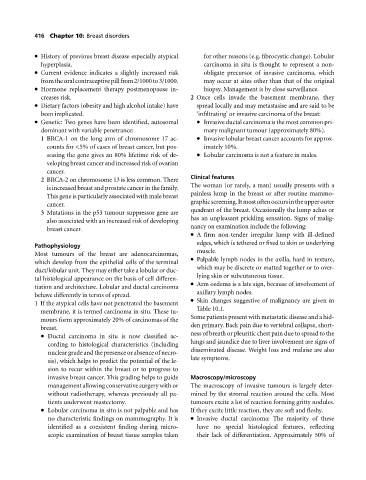Page 420 - Medicine and Surgery
P. 420
P1: KTX
BLUK007-10 BLUK007-Kendall May 12, 2005 20:3 Char Count= 0
416 Chapter 10: Breast disorders
History of previous breast disease especially atypical for other reasons (e.g. fibrocystic change). Lobular
hyperplasia. carcinoma in situ is thought to represent a non-
Current evidence indicates a slightly increased risk obligate precursor of invasive carcinoma, which
fromtheoralcontraceptivepillfrom2/1000to3/1000. may occur at sites other than that of the original
Hormone replacement therapy postmenopause in- biopsy. Management is by close surveillance.
creases risk. 2 Once cells invade the basement membrane, they
Dietary factors (obesity and high alcohol intake) have spread locally and may metastasise and are said to be
been implicated. ‘infiltrating’ or invasive carcinoma of the breast:
Genetic: Two genes have been identified, autosomal Invasive ductal carcinoma is the most common pri-
dominant with variable penetrance: mary malignant tumour (approximately 80%).
1 BRCA-1 on the long arm of chromosome 17 ac- Invasive lobular breast cancer accounts for approx-
counts for <5% of cases of breast cancer, but pos- imately 10%.
sessing the gene gives an 80% lifetime risk of de- Lobular carcinoma is not a feature in males.
veloping breast cancer and increased risk of ovarian
cancer.
2 BRCA-2 on chromosome 13 is less common. There Clinical features
The woman (or rarely, a man) usually presents with a
is increased breast and prostate cancer in the family.
painless lump in the breast or after routine mammo-
This gene is particularly associated with male breast
graphicscreening.Itmostoftenoccursintheupperouter
cancer.
quadrant of the breast. Occasionally the lump aches or
3 Mutations in the p53 tumour suppressor gene are
has an unpleasant prickling sensation. Signs of malig-
also associated with an increased risk of developing
nancy on examination include the following:
breast cancer.
Afirm non-tender irregular lump with ill-defined
edges, which is tethered or fixed to skin or underlying
Pathophysiology
muscle.
Most tumours of the breast are adenocarcinomas,
Palpable lymph nodes in the axilla, hard in texture,
which develop from the epithelial cells of the terminal
which may be discrete or matted together or to over-
duct/lobular unit. They may either take a lobular or duc-
lying skin or subcutaneous tissue.
tal histological appearance on the basis of cell differen-
Armoedema is a late sign, because of involvement of
tiation and architecture. Lobular and ductal carcinoma
axillary lymph nodes.
behave differently in terms of spread.
Skin changes suggestive of malignancy are given in
1 If the atypical cells have not penetrated the basement
Table 10.1.
membrane, it is termed carcinoma in situ. These tu-
Some patients present with metastatic disease and a hid-
mours form approximately 20% of carcinomas of the
den primary. Back pain due to vertebral collapse, short-
breast.
ness of breath or pleuritic chest pain due to spread to the
Ductal carcinoma in situ is now classified ac-
lungs and jaundice due to liver involvement are signs of
cording to histological characteristics (including
disseminated disease. Weight loss and malaise are also
nuclear grade and the presence or absence of necro-
late symptoms.
sis), which helps to predict the potential of the le-
sion to recur within the breast or to progress to
invasive breast cancer. This grading helps to guide Macroscopy/microscopy
management allowing conservative surgery with or The macroscopy of invasive tumours is largely deter-
without radiotherapy, whereas previously all pa- mined by the stromal reaction around the cells. Most
tients underwent mastectomy. tumours excite a lot of reaction forming gritty nodules.
Lobular carcinoma in situ is not palpable and has If they excite little reaction, they are soft and fleshy.
no characteristic findings on mammography. It is Invasive ductal carcinoma: The majority of these
identified as a coexistent finding during micro- have no special histological features, reflecting
scopic examination of breast tissue samples taken their lack of differentiation. Approximately 50% of

